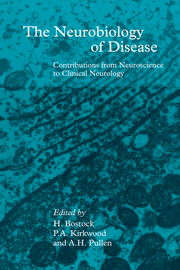Book contents
- Frontmatter
- Contents
- List of contributors
- Preface
- Part I Physiology and pathophysiology of nerve fibres
- 1 Ion channels in normal and pathophysiological mammalian peripheral myelinated nerve
- 2 Molecular anatomy of the node of Ranvier: newer concepts
- 3 Delayed rectifier type potassium currents in rabbit and rat axons and rabbit Schwann cells
- 4 Axonal signals for potassium channel expression in Schwann cells
- 5 Ion channels in human axons
- 6 An in vitro model of diabetic neuropathy: electrophysiological studies
- 7 Autoimmunity at the neuromuscular junction
- 8 Immunopathology and pathophysiology of experimental autoimmune encephalomyelitis
- 9 Pathophysiology of human demyelinating neuropathies
- 10 Conduction properties of central demyelinated axons: the generation of symptoms in demyelinating disease
- 11 Mechanisms of relapse and remission in multiple sclerosis
- 12 Glial transplantation in the treatment of myelin loss or deficiency
- Part II Pain
- Part III Control of central nervous system output
- Part IV Development, survival, regeneration and death
- Index
7 - Autoimmunity at the neuromuscular junction
from Part I - Physiology and pathophysiology of nerve fibres
Published online by Cambridge University Press: 04 August 2010
- Frontmatter
- Contents
- List of contributors
- Preface
- Part I Physiology and pathophysiology of nerve fibres
- 1 Ion channels in normal and pathophysiological mammalian peripheral myelinated nerve
- 2 Molecular anatomy of the node of Ranvier: newer concepts
- 3 Delayed rectifier type potassium currents in rabbit and rat axons and rabbit Schwann cells
- 4 Axonal signals for potassium channel expression in Schwann cells
- 5 Ion channels in human axons
- 6 An in vitro model of diabetic neuropathy: electrophysiological studies
- 7 Autoimmunity at the neuromuscular junction
- 8 Immunopathology and pathophysiology of experimental autoimmune encephalomyelitis
- 9 Pathophysiology of human demyelinating neuropathies
- 10 Conduction properties of central demyelinated axons: the generation of symptoms in demyelinating disease
- 11 Mechanisms of relapse and remission in multiple sclerosis
- 12 Glial transplantation in the treatment of myelin loss or deficiency
- Part II Pain
- Part III Control of central nervous system output
- Part IV Development, survival, regeneration and death
- Index
Summary
The neuromuscular junction is arguably the best understood synapse in the human nervous system. Building on the pioneering studies in the frog (see Katz, 1969), Elmqvist et al (1964) and Elmqvist & Lambert (1968) defined the principal properties of nerve-to-muscle transmission in man, based on observations made on biopsied human intercostal muscle. At that time, the neuromuscular junction was believed to be the site of the disorder in myasthenia gravis (MG), but its physiological mechanism was not known until the studies of Elmqvist et al. (1964) revealed a reduction in the amplitudes of the miniature endplate potentials and of the endplate potentials. The later discovery of MG's antibody-mediated nature was made possible by the earlier physiological studies. Subsequently, it has become clear that MG is not the only autoimmune disorder affecting the neuromuscular junction. Its vulnerability may be because the ion channels and cell surface molecules concerned in synaptic transmission, unlike those at synapses elsewhere in the nervous system, lie outside the blood–brain barrier and thus lack the protection from systemic immune attack that the latter affords.
This chapter will first describe the background for the autoimmune process in MG, a postsynaptic disorder, before describing two other disorders distinct from MG in which the targets for immune attack are presynaptic.
Myasthenia gravis
That MG might be an autoimmune disease was first suggested by Simpson (1960) who deduced this from clinical clues: its association with other autoimmune disease (notably of the thyroid) and the transfer of the disorder transiently to babies born to myasthenic mothers.
- Type
- Chapter
- Information
- The Neurobiology of DiseaseContributions from Neuroscience to Clinical Neurology, pp. 69 - 74Publisher: Cambridge University PressPrint publication year: 1996

